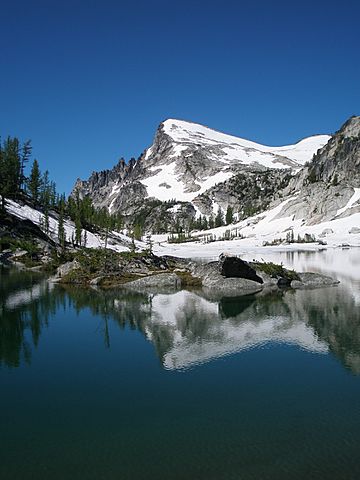Little Annapurna facts for kids
Quick facts for kids Little Annapurna |
|
|---|---|

Little Annapurna from Rune Lake
|
|
| Highest point | |
| Elevation | 8,440 ft (2,570 m) |
| Prominence | 280 ft (85 m) |
| Geography | |
| Location | Chelan County, Washington state, U.S. |
| Parent range | Cascade Range Wenatchee Mountains Stuart Range |
| Topo map | USGS Enchantment Lakes |
| Type of rock | Granite |
| Climbing | |
| Easiest route | Scrambling class 2 |
Little Annapurna is a tall mountain peak in Washington state, U.S. It stands over 8,440 feet (2,573 meters) high. This impressive granite summit is located in Chelan County.
The mountain got its name from the Sherpa Climbing Club of Ellensburg. They thought it looked a lot like the famous Annapurna mountain in the Himalayas. Little Annapurna is part of a beautiful area called The Enchantments. This area is inside the Alpine Lakes Wilderness. The land around it is managed by the Okanogan-Wenatchee National Forest.
Little Annapurna is part of the Stuart Range, which is a smaller part of the larger Cascade Range. It sits southeast of Dragontail Peak, which is an even taller mountain nearby. You can still find parts of the Snow Creek Glacier on its gentle north side. Water from rain and melting snow flows into streams that feed the Wenatchee River.
Weather and Climate in the Mountains
The weather in the Cascade Mountains is very interesting! Most weather systems start over the Pacific Ocean. They then move east towards the Cascade Range. When these weather systems hit the tall mountains, they are forced to rise. This causes them to drop their moisture as rain or snowfall onto the mountains. This process is called Orographic lift.
Because of this, the Cascade Mountains get a lot of rain and snow. Winters are usually cloudy with heavy snowfall. But in summer, high-pressure systems over the Pacific Ocean often bring clear skies. The snow here tends to be wet and heavy because of the ocean's influence. This can sometimes lead to a high risk of avalanches.
How the Mountains Were Formed
The Alpine Lakes Wilderness has some of the most rugged land in the Cascade Range. You can see jagged peaks, deep valleys carved by glaciers, and huge granite walls. There are also more than 700 mountain lakes!
These amazing landscapes were created by powerful geological events millions of years ago. The formation of the Cascade Mountains began during the late Eocene Epoch. This was when the North American Plate slowly moved over the Pacific Plate. This movement caused a lot of volcanic activity.
Also, small pieces of the Earth's crust, called terranes, joined together. This helped form the North Cascades about 50 million years ago.
Later, during the Pleistocene period (which started over two million years ago), glaciers played a big role. Huge sheets of ice moved across the land, carving out valleys. They left behind piles of rock and debris. The last glaciers in the Alpine Lakes area started melting about 14,000 years ago. The "U"-shaped valleys you see today were formed by these powerful glaciers. The combination of land uplift, faulting, and glaciation created the tall peaks and deep valleys of this wilderness area.



